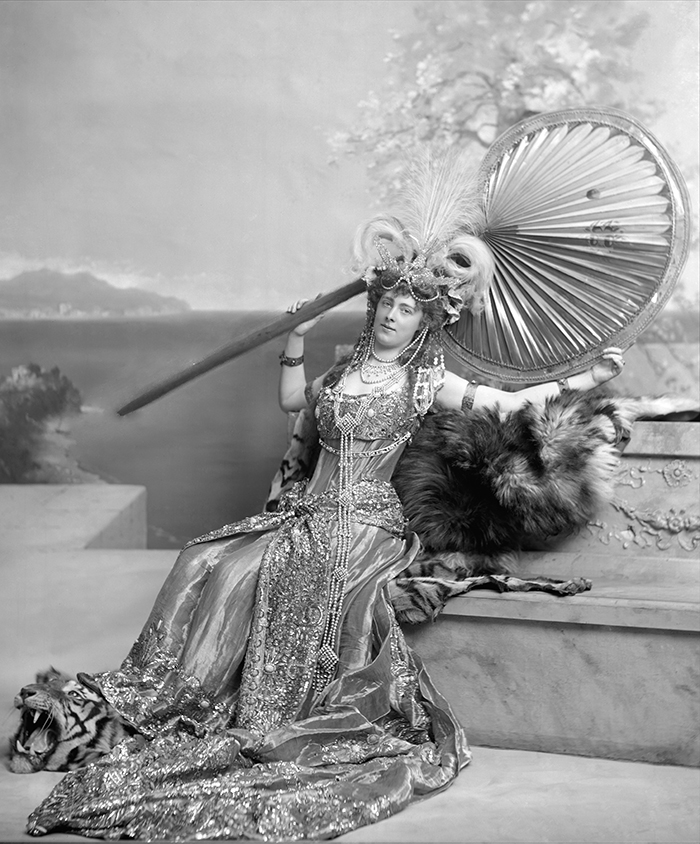
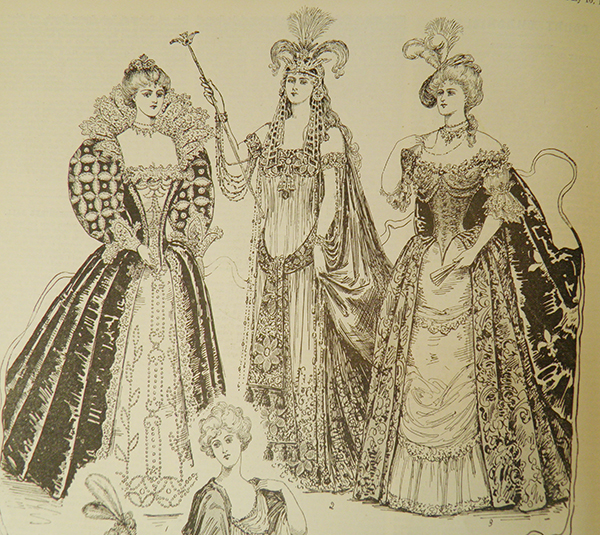
Sketch published in The Queen, 10 July 1897
Daisy of Pless, centre
Image published in Daisy of Pless: The Happy Years
Image displayed in:
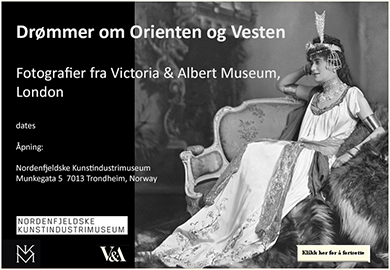
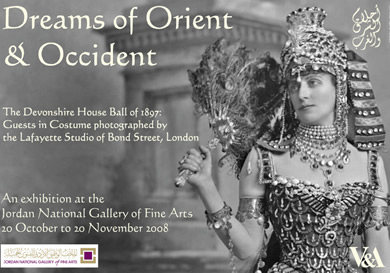
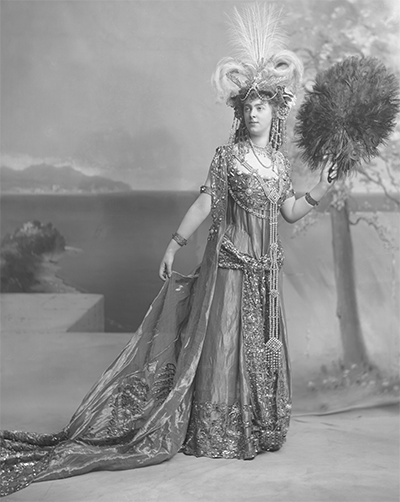
Along with Queen Marie of Romania, Daisy of Pless (who married the Silesian Prince Hans Heinrich XV in 1891) was considered one of the most beautiful royal women in Europe.
Her good looks and poses were later to be immortalised both on canvas by the celebrated portrait painters John Singer Sargent, as well as by many other painters such as Boleslaw Szankowski, Ellis William Roberts and Paul-César Helleu, and captured on glass negatives at many photographic sessions at the fashionable London studios, including that of Lafayette, in a variety of fanciful, and sometimes derivative, poses emphasising her semi-sensuous conception of royalty as well as embodying Schlegel's maxim: "Look to the Orient for all that is romantic!"
In addition to her increasingly difficult life as an unassimilated Englishwoman in Germany in the years leading up to, and during, the First World War, the loss of her husband’s estates to the new country of Poland after 1918 brought about an estrangement between the couple and the later years of her life ended in divorce, separation from her family, poverty, debilitating illness and a lonely death in territory occupied by Germany during the Second World War.
A portrait made on the night of the Ball was published in The Graphic a week after the event. The negative no longer exists in the Lafayette archive, and Daisy, obviously intent upon having a more flattering portrait, was back at the studio in December 1897 later for a more satisfying series of images in this costume.
In the reclining portrait, made six months after the Ball, the princess, with almost identical placement of the hands, holds the same enormous palm-leaf pankha that her mother, Patsy, held in an 1881 “professional beauty” portrait produced by the London firm of Downey.
As the Queen of Sheba, Daisy wears a dress of purple and gold shot gauze. The train is a mass of red, purple, green, blue and white jewels, thickly encrusting medallions of raised gold. The dress is also set with turquoise ovals with engraved hieroglyphics. Over this she wears a sash of cloth of gold also heavily bejewelled and a massive pearl and diamond sautoir. The costume is topped off with an Assyrian headdress studded with turquoises, emeralds and pearls, with jewels over either ear. The ensemble was described by the press as “a costume of the utmost magnificence.”
Princess Daisy had a little competition for her character, or as The Queen, put it:
“Lady Cynthia Graham also looked splendid as Queen of Sheba: but Daisy, with four black slaves carrying her train, was considered the more beautiful of the two."
Her outfit, one of many designed for the Ball by Mrs Mason of London, “must have cost several hundred pounds” - according to one American newspaper, which also declared that “anything more beautiful than Princess Pless’s dress has never been seen.”
Other objects, creating an oriental ambience, can be seen in the photograph - such as the fur throw and a backdrop in the style of the Dutch classicist and orientalist painter, Lawrence Alma Tadema (1836-1912) who was active in England. Although the Devonshire House Ball had taken place on the night of the 2 July 1897, this portrait was made over six months later and was reproduced in the Album.
In one of the standing (top) images from the same photographic session, Princess Daisy is seen with an ostrich feather fan. Very unusually for the Princess, her loosely fitting dress and stance fail to highlight her minute waist.
The extant four negatives from this photographic session show clearly how a sitter, even in a fancy dress, might go through a variety of poses and use various studio props in an effort to add some dynamism to a photographic study. As Princess Daisy was a well-known performer on stage for society and charitable events, it might be surmised that she, and not the photographer, was directing the shoot.
The image published in the Album was erroneously entitled ‘as Cleopatra’, but the following image in the Album, of Daisy’s as yet unmarried sister Shelagh lists her as ‘a courtier in the train of Queen of Sheba’.
Ev'ry sight these eyes behold
Does a different charm unfold;
Flashing gems and sculptur'd gold,
Still attract my ravish'd sight
Georg Friedrich Händel, Solomon (1749), Act III
Words attributed to Newburgh Hamilton
|
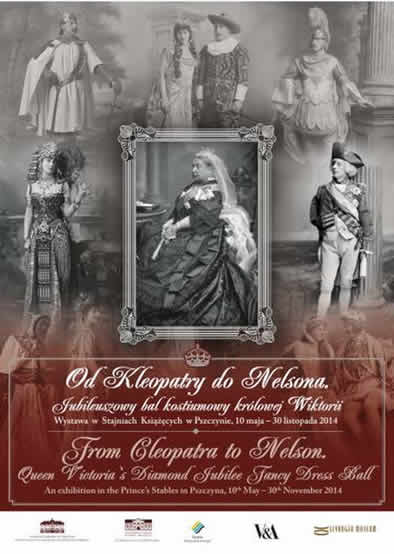
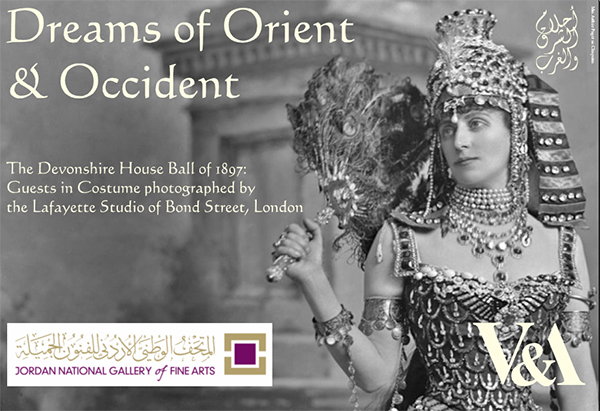
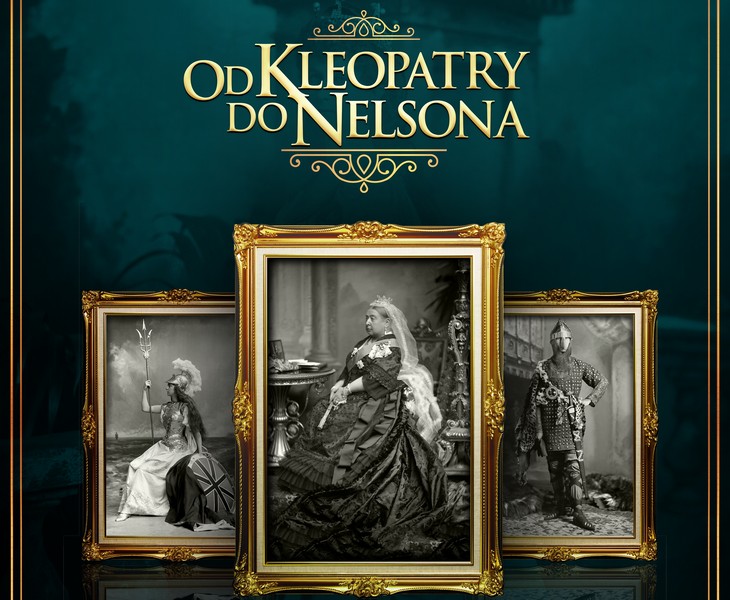
|
|
Biog: Society beauty;
eldest dau of Col. Frederick Richard Cornwallis-West of Ruthin Castle,
Denbighshire; m (1891) Hans Heinrich, 15th Prince and 3rd Duke of Pless
(div 1922).
Role: Queen of Sheba/Cleopatra.
Date: 29 December
1897.
Occasion: The Devonshire
House Ball, 2 July 1897.
Location: The Lafayette
Studio, 179 New Bond Street, London, W.
Descr: FL seated.
Costume: "...dress...of
purple and gold shot gauze. The bodice, the skirt nearly to the waist,
and the train was one mass of jewels, thickly encrusting medallions of
raised gold. Turquoise, bearing hieroglyphics, bore a prominent part in
the design, which included yellow, red, purple, green, blue, and white
stones. There was a sash of cloth of gold also jewelled superbly, and
the Assyrian badge worn in front of the bodice at the waistline. An Assyrian
headdress, with jewels over either ear, and a high jewelled stiff feather
and chains of diamonds and turquoise worn slung on either arm from shoulder
to wrist, completed a costume of the utmost magnificence." (The
Daily Telegraph, 3 July 1897, p 10a).
Costume Supplier:
Mrs. Mason, 4 New Burlington Street, London W., or Mrs. Harrison, 5 Crawford
Street, London, W.
Furniture & Props:
Painted backdrop;a fan.

Photographer: The
firm of J. Lafayette, 179 New Bond Street, London, W.
Evidence of photographer at
work: -
No of poses: 4 [see
also neg nos 1595A, 1598 and 1598B].
Copyright: V&A
All
images on this site are copyright V&A. For further information on
using or requesting copies of any images
please contact the V&A Picture Library: vaimages@vam.ac.uk
including the URL of the relevant page
Provenance: Pinewood Studios; acquired 1989.

References:
Biog: Alamanac
de Gotha; Burke's Landed Gentry; Burke's Peerage (see De La Warr);
Marquis of Ruvigny, The Titled Nobility of Europe, London, 1914;
Who's Who; The Times, 13 July 1943, p 6e. (See also
Daisy, Princess of Pless, Daisy Princess of Pless, by Herself,
London, 1928; More About Myself and Friends, London, 1930 CK;
From My Private Diary, London, 1931; What I Left Unsaid,
London, 1936.)
Role: (Queen
of Sheba) All known press sources (Cleopatra)
Devonshire House Fancy Dress Ball, July 2 1897: A Collection of Portraits
in Costume of Some of the Guests, privately printed, 1899, p 85
(National Portrait Gallery Archives).
Occasion: Sophia
Murphy, The Duchess of Devonshire's Ball, London, 1984.
Costume: The
Boston Post, 3 July 1897, p 1b; The Chicago Tribune, 3 July
1897, p 3a; The Daily Chronicle, 3 July 1897, p 8a;
The Daily News, 3 July 1897, p 5g; The Daily Telegraph,
3 July 1897, p 10a; The Irish Times, 3 July 1897, p 8c;
Madame, 3 July 1897, p 69a; The Morning Post, 3
July 1897, p 7g; Pall Mall Gazette, 3 July 1897, p 7b;
St. James's Gazette, 3 July 1897, p 8b; The Standard,
3 July 1897, p 4b; The Times, 3 July 1897, p 12b; The
Westminster Gazette, 3 July 1897, p 5b; The Lady, 8
July 1897, p 46a [& line drawing]; Truth, 8 July 1897,
p 108a; Vanity Fair, 8 July 1897, p 26b; Black and White,
10 July 1897, p 56a; The Court Circular, 10 July 1897, p 624a;
The Court Journal, 10 July 1897, p 1247a; The Gentlewoman,
10 July 1897, p 48b; The Graphic 10 July 1897, p 78c;
Lady's Pictorial, 10 July 1897, p 53a [& p 42 line
drawing]; The Queen, 10 July 1897, p 74 [& line
drawing].
Costume Supplier:
(Mrs. Mason) The Daily Chronicle, 3 July 1897,
p 8a; Vanity Fair, 8 July 1897, p 18b; The
Queen, 10 July 1897, p 74); (Mrs. Harrison) Truth,
8 July 1897, p 108a.
Reproduced: Devonshire
House Fancy Dress Ball, July 2 1897: A Collection of Portraits in Costume
of Some of the Guests, privately printed, 1899, p 85 (National
Portrait Gallery Archives). (Lafayette photograph taken on the
night of the Ball) Black and White, 10 July 1897,
p 39; The Graphic 10 July 1897, p 78; The Sketch,
14 July 1897, p 488.

|